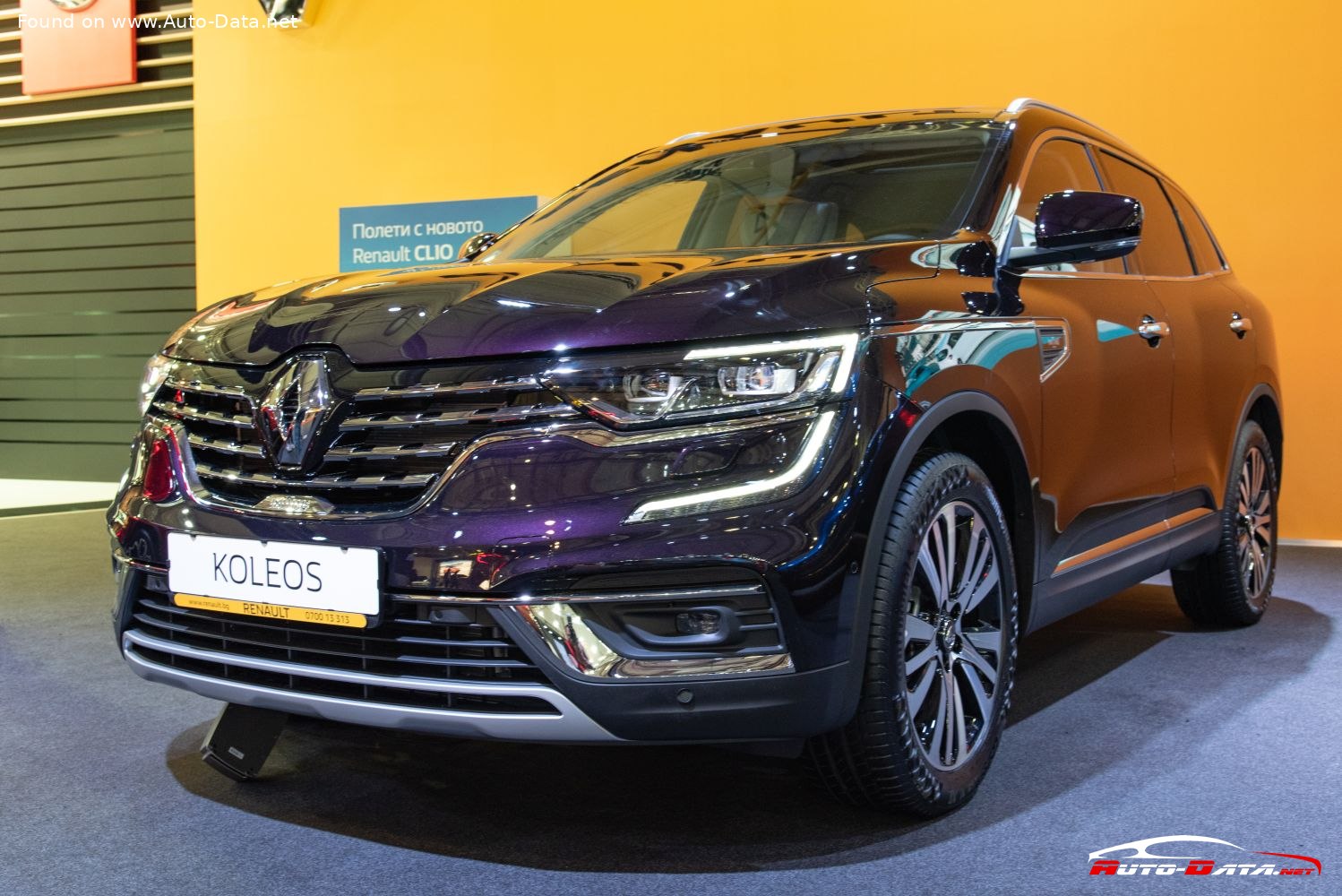2019 Renault Koleos II (Phase II, 2019) 1.7 Blue dCi (150 Hp) X-Tronic | Specifications




















| Approach angle | 18.4° |
| Departure angle | 24.7° |
| Front overhang | 929 mm |
| Front track | 1591 mm |
| Height | 1667 mm |
| Length | 4673 mm |
| Minimum turning circle (turning diameter) | 11.4 m |
| Rear (Back) track | 1586 mm |
| Rear overhang | 1039 mm |
| Ride height (ground clearance) | 189 mm |
| Wheelbase | 2705 mm |
| Width | 1813 mm |
| Width including mirrors | 2063 mm |
Performance specs
| Acceleration 0 - 100 km/h | 11.8 sec |
| Acceleration 0 - 60 mph | 11.2 sec |
| Acceleration 0 - 62 mph | 11.8 sec |
| CO2 emissions | 143 g/km |
| CO2 emissions (WLTP) | 161-162 g/km |
| Combined fuel consumption (WLTP) | 6.1-6.2 l/100 km |
| Emission standard | Euro 6 d-TEMP |
| Fuel Type | Diesel |
| Fuel consumption (economy) - combined | 5.4 l/100 km |
| Fuel consumption (economy) - extra urban | 4.9 l/100 km |
| Fuel consumption (economy) - urban | 6.1 l/100 km |
| Maximum speed | 190 km/h |
| Weight-to-power ratio | 11.2 kg/Hp, 89.1 Hp/tonne |
| Weight-to-torque ratio | 5 kg/Nm, 202 Nm/tonne |
Space, Volume and weights
| AdBlue tank | 16 l |
| Fuel tank capacity | 60 l |
| Kerb Weight | 1683 kg |
| Max load | 557 kg |
| Max. weight | 2240 kg |
| Trunk (boot) space - maximum | 1706 l |
| Trunk (boot) space - minimum | 498 l |
Engine specs
| Cylinder Bore | 80 mm |
| Engine Model/Code | R9N A4 |
| Engine aspiration | Turbocharger, Intercooler |
| Engine configuration | Inline |
| Engine displacement | 1749 cm3 |
| Engine layout | Front, Transverse |
| Engine systems | Particulate filter |
| Fuel injection system | Diesel Commonrail |
| Number of cylinders | 4 |
| Number of valves per cylinder | 4 |
| Piston Stroke | 87 mm |
| Power | 150 Hp @ 3500 rpm. |
| Power per litre | 85.8 Hp/l |
| Torque | 340 Nm @ 1750 rpm. |
Drivetrain, brakes and suspension specs
| Assisting systems | ABS (Anti-lock braking system) |
| Drive wheel | Front wheel drive |
| Drivetrain Architecture | The Internal combustion engine (ICE) drives the front wheels of the vehicle. |
| Front brakes | Ventilated discs, 320 mm |
| Front suspension | Independent type McPherson |
| Number of gears and type of gearbox | automatic transmission X-Tronic |
| Rear brakes | Disc, 292 mm |
| Rear suspension | Independent multi-link suspension |
| Steering type | Steering rack and pinion |
| Tires size | 225/65 R17 102H; 225/60 R18 100H; 225/55 R19 99V |
| Wheel rims size | 17; 18; 19 |
General information
| Body type | SUV |
| Brand | Renault |
| Doors | 5 |
| End of production | November, 2020 year |
| Generation | Koleos II (Phase II, 2019) |
| Model | Koleos |
| Modification (Engine) | 1.7 Blue dCi (150 Hp) X-Tronic |
| Powertrain Architecture | Internal Combustion engine |
| Seats | 5 |
| Start of production | September, 2019 year |
Frequently Asked Questions
Here are answers to some common questions
The VIN number, also known as the VIN code, is the vehicle identification number. VIN is an abbreviation of the English term Vehicle Identification Number. The VIN number is a unique set of 17 characters that car manufacturers assign to all vehicles they produce. The VIN code can be found on various parts of the car body or in the registration documents.
In the CarVertical vehicle report, you will find the most important information about the vehicle that will allow you to assess the condition of the vehicle. In the report, you will find information such as vehicle mileage, accident data, countries of previous registrations, records from searched car databases, and much more useful information.
CarVertical reports are available immediately or can take up to a few minutes. The service is provided 24 hours a day, 7 days a week, reports are generated automatically. It basically takes as long as it takes to process your payment - the sooner the money reaches your CarVertical account, the sooner you will receive a report.
First of all, CarVertical is generally the world's first provider of VIN history reports by car code, receiving some of the data in real-time directly from the car. The information obtained in this way is the most up-to-date, which is why it is so operative. In addition, CarVertical uses BlockChain technology, so the data available to CarVertical is genuine and real.
Information about cars is obtained from many sources, including car services, national registers of various countries, insurance companies, "connected" car parks, and so on.
